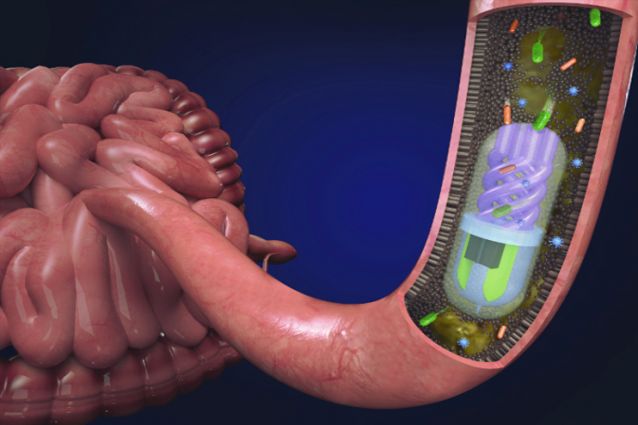A research project led by Tufts University has developed a 3D printed pill that can sample bacteria found in the gut (also known as the microbiome) as it passes through the gastrointestinal tract when ingested. By profiling bacterial species located within the gut, researchers can increase understanding of conditions and diseases related to the intestinal microbiome that could prove significant.
As described in a study published in the Advanced Intelligent Systems journal, the 3D printed pill is considered the first non-invasive diagnostic tool that can provide a profile of microbiome populations in the gastrointestinal tract., according to the researchers. Methods that are currently used to sample the microbiome primarily involve the invasive procedures of analysing fecal DNA and metabolites. These methods can sometimes prove ineffective and inaccurate, providing little information in areas where bacterial species can vary significantly.
“We have advanced technologies to analyze bacterial populations using DNA sequencing, but until now have not had a way to sample bacteria throughout the GI tract in a way that is not invasive,” commented Hojatollah Rezaei Nejad, a post-doctoral fellow studying novel applications of 3D printing at Tufts and lead author of the study.
“By sampling non-invasively, this pill could help us better identify and understand the role of different intestinal bacterial species in health and disease.”

Understanding and preventing diseases with 3D printing
The pill was 3D printed with microfluidic channels, giving it the ability to sample different stages of the gastrointestinal tract. On the surface of the pill is a pH sensitive coating, preventing the pill from absorbing samples until it bypasses the stomach and enters the small intestine, where the coating then dissolves. Two chambers in the pill are separated by a semipermeable membrane. One of the chambers contains helical channels that take up the bacteria, whereas the other is filled with calcium salt. The salt chamber helps to pull the bacteria into the helical channels in a process known as osmosis.
Furthermore, a small magnet has been implemented within the pill, enabling the use of a magnet from outside of the body to control it. The pill can then be moved and held at specific locations in the gut for more spatially targeted sampling. “The design of this device makes it incredibly easy to use, posing little risk to the subject, yet providing so much information,” explained Giovanni Widmer, professor of infectious disease and global health at Cummings School of Veterinary Medicine at Tufts University.
The 3D printed pill has been placed under strenuous tests by Tufts researchers, both in vitro and in vivo. With their findings, the researchers concluded that the pill is able to provide an accurate identification of bacterial populations and their relative abundance. However, it has only been tested in pigs and primates thus far. Clinical trials are needed in order to determine if the 3D printed pill can be used in humans for routine clinical care.
Over 1,000 species of bacteria are present within a healthy gut, although most of them provide digestive benefits and protection against disease. However, it is possible to disturb the natural balance of the microbiome, which can cause inflammation, susceptibility to infections and the exacerbation of other diseases such as cancer. The 3D printed pill has the potential to play an important role in research investigating the specific microbiome metabolites that have beneficial or protective effects against disease.
“We are learning quite a lot about the role of gut microbiome in health and disease. However, we know very little about its biogeography,” added Sameer Sonkusale, professor of electrical and computer engineering at Tufts University’s School of Engineering and corresponding author of the study.
“The pill will improve our understanding of the role of spatial distribution in the microbiome profile to advance novel treatments and therapies for a number of diseases and conditions.”

3D printed pills create new advancements for medicine
Although the pill may prove significant as a non-invasive diagnostic tool, it is not the first instance where 3D printing has been utilized to produce pills with unique benefits in medicine and health.
In December 2018, a project was undertaken at Massachusetts Institute of Technology (MIT) where researchers developed a 3D printed pill that collected data from inside a person’s stomach. The pills are designed to sit in the stomach for over a month, sensing the development of infection, or the body’s response to medication, and even administering therapeutic drugs.
A research team at St. John’s University, New York on the other hand have designed and tested 3D printed tablets aimed at deterring opioid abusers from misusing pharmaceuticals. The thermoplastic tablets are 3D printed in an egg shape, which help to make it difficult to misuse strong prescription drugs.
FabRx, a UCL spinout company seeking commercialize 3D printed medicines and devices, has also developed its own 3D printed pills. The company is working on a collaborative project to commercialize 3D printer hardware and materials that can produce personalized medicines for human consumption. The UK government’s Technology Strategy Board Innovate UK has granted over £650,000 to the project in question.
Subscribe to the 3D Printing Industry newsletter for the latest news in additive manufacturing. You can also keep connected by following us on Twitter and liking us on Facebook.
Looking for a career in additive manufacturing? Visit 3D Printing Jobs for a selection of roles in the industry.
Featured image shows microbiome sampling pill in the small intestine. Image via Nano Lab, Tufts University.


